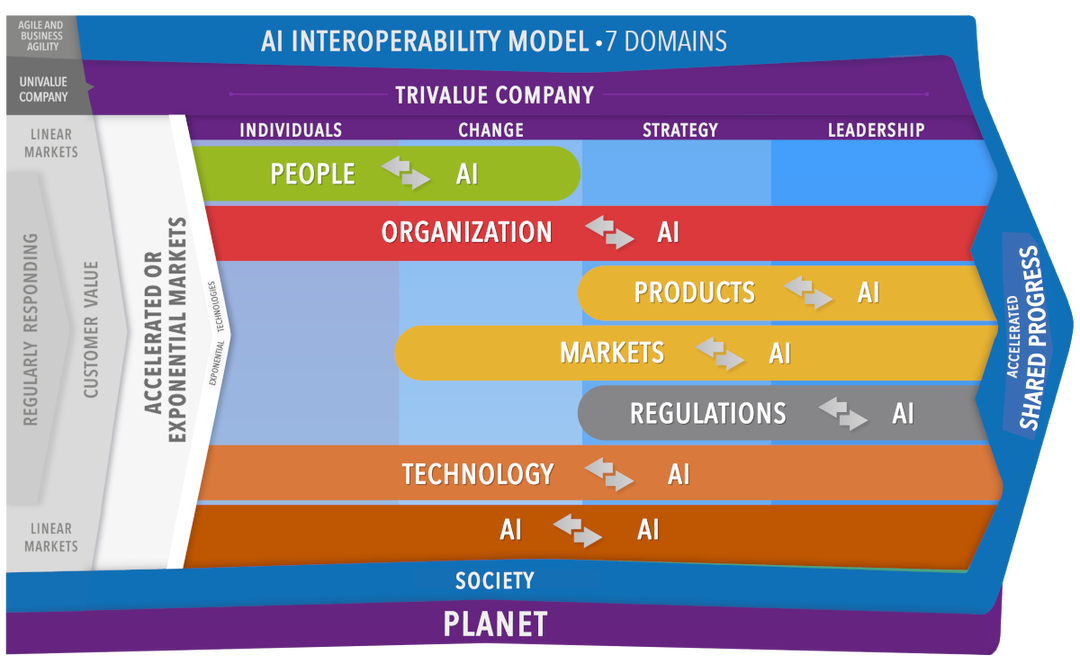Artificial intelligence (AI) is transforming the way organizations operate, innovate, and create value. To harness the full potential of AI and ensure its benefits are shared by all, we need a comprehensive framework that considers the complex interplay between technology, people, and society. This is where the AI Interoperability Model comes in.

What is the AI Interoperability Model?
The AI Interoperability Model is a groundbreaking framework that enables organizations to develop and deploy AI systems that create value for customers, companies, and employees while aligning with societal needs and values. It consists of seven interconnected domains:
PEOPLE
At the heart of AI interoperability are those who design, develop, deploy, and use AI systems for their work or to magnify their skills. This domain focuses on the interactions between humans and AI, and how AI can empower and augment human capabilities. One key aspect of this domain is the need for AI systems to be transparent, explainable, and accountable to the people they serve. This involves ensuring that AI systems are designed with human values and priorities and that non-technical stakeholders can easily understand and use them. Another important consideration is the need for AI systems to adapt to and learn from human behavior by detecting their biases. This means developing AI systems that can sense and understand biases and respond to human emotions, preferences, and contexts and that can continuously improve based on feedback and user interaction. An essential area of this domain is to ensure that it can minimize stress on people when situations radically change.
ORGANIZATIONS
Organizations are one of the primary adopters and beneficiaries of AI systems and play a critical role in shaping the development and deployment of AI to build better and more sustainable societies. This domain focuses on how companies can leverage AI to sustainably enhance their operations, products, and services while ensuring that AI is developed and used ethically and responsibly. One key challenge in this domain is the need for organizations to develop clear governance frameworks and policies for AI development and use. This means establishing standards and guidelines for data privacy, security, fairness, and transparency and ensuring that AI systems are aligned with organizational values and goals and are not just used to replace employees to satisfy shareholders. Companies should also be aware of the information that AI consumes to improve everything done. The open information and the internet are huge, but many potential downsides exist. Another important consideration is the need for organizations to foster a culture of innovation and experimentation around AI. This involves creating an environment where employees are encouraged to explore new ideas and approaches and where failure is seen as an opportunity for learning and growth.
PRODUCTS
Products are the tangible outputs of AI systems and are the primary way AI creates value for customers or other stakeholders. This domain focuses on integrating AI into products and services to enhance functionality, usability, and value. One key challenge in this domain is the need for AI-powered products to be designed with stakeholders' needs and preferences in mind. This means developing intuitive, responsive, and dynamically adaptable products to different user contexts and requirements. Another important consideration is the need for AI-powered products to improve and update continuously based on user feedback and data. This involves establishing feedback loops and data pipelines that allow products to learn and evolve over time, enabling organizations to quickly respond to changing user needs and market conditions with low stress on their structures and people.
MARKETS
Markets or accelerated markets are the broader economic and social contexts in which AI systems are developed and deployed. This domain focuses on how AI shapes and is shaped by market forces, including competition, demand, regulation, and acceleration. One key challenge in this domain is the need for markets to be transparent and fair in the development and deployment of AI. This implies ensuring that AI systems are not used to perpetuate biases or discrimination and that the benefits of AI are distributed equitably across different stakeholders and communities. Another important consideration is the need for markets to foster innovation and competition around AI. This also means creating an environment where new entrants and ideas can flourish and established players are incentivized to continuously improve and adapt to changing market conditions.
REGULATIONS
Regulations are the legal and policy frameworks that govern the development and use of AI systems. This domain focuses on how regulations can be designed to promote innovation and shared value creation while protecting the rights and interests of individuals and society as a whole. One key challenge in this domain is the need for regulations to be adaptive and responsive to the rapidly evolving nature of AI. This indicates developing regulatory frameworks that are flexible enough to accommodate new technologies and use cases while also providing clear guidelines and standards for ethical and responsible AI development. Another important consideration is the need for regulations to be developed in collaboration with various stakeholders, including industry, academia, civil society, and government. This implies creating public participation and input mechanisms and ensuring that diverse perspectives and expertise inform regulations. Another critical challenge is ensuring that AI's information is high quality, not just information produced and published by organizations interested in shaping an alternative reality.
TECHNOLOGIES
Technologies are the underlying tools, platforms, and infrastructures that enable the development and deployment of any system or product. This domain focuses on how different technologies can be integrated and leveraged to create value through AI. One key challenge in this domain is the need for technologies to be interoperable and scalable across different domains and use cases. This involves developing common standards and protocols for data exchange, model development, and system architecture and ensuring that different technologies can work together seamlessly to support AI development and deployment. Another important consideration is the need for technologies to be secure, reliable, and resilient in the face of evolving threats and challenges. This implies developing robust security frameworks and practices and ensuring AI systems can operate effectively despite disruptions or attacks.
AI-TO-AI
Finally, the domain of AI-to-AI focuses on how different AI systems can communicate, collaborate, and coordinate with each other to achieve common goals and objectives and advance our society. This involves developing frameworks and protocols for AI-to-AI communication and ensuring that different AI systems can work together seamlessly to solve complex problems and create value. One key challenge in this domain is the need for AI systems to be able to negotiate and resolve conflicts transparently and fairly. This involves developing mechanisms for AI systems to share information, resources, and decision-making power and ensuring that AI-to-AI interactions' outcomes align with broader societal values and priorities. Another consideration is the need for AI-to-AI interactions to be scalable and adaptable to different contexts and requirements. This implies developing frameworks and architectures that can support the integration and coordination of large numbers of AI systems and evolve and adapt over time as new technologies that are sustainable for the planet.
Why is the AI Interoperability Model Important?
The AI Interoperability Model is crucial because it provides a holistic and adaptive approach to AI adoption and integration. By considering the interconnections and dependencies between the seven domains, organizations can:
- Develop AI systems that are more transparent, accountable, and aligned with human values and priorities
- Foster cross-domain collaboration and knowledge sharing to accelerate innovation and value creation
- Anticipate and prepare for future challenges and opportunities related to AI
- Ensure that the benefits of AI are distributed fairly and equitably across society
By combining the AI Interoperability Model with Enterprise Agility, organizations can:
- Develop the mental agility and resilience needed to navigate the complexities of AI adoption and integration
- Foster a culture of innovation, learning, and collaboration that supports continuous improvement and adaptation
- Leverage the power of strategic foresight and value mapping to identify new opportunities for growth and value creation
- Build ecosystem partnerships and collaborations that enable shared progress and collective intelligence
In essence, the AI Interoperability Model and Enterprise Agility work together to help organizations navigate the future of AI in a way that benefits all stakeholders and contributes to a more sustainable, equitable, and prosperous world. By embracing this holistic approach, organizations can unlock the transformative potential of AI and shape a future that works for everyone.
